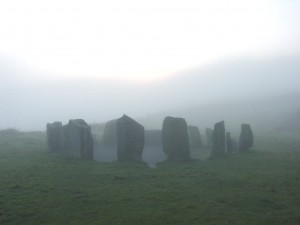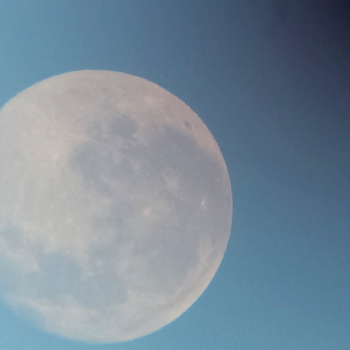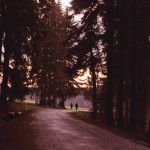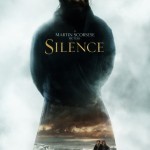 “What is a thin place?” the friendly female voice asks in the YouTube video that I watch before departure for a family sabbatical to Ireland. At the moment I’m between a rock and a hard place on a hot day in Brooklyn, trying to get ready. But on this break, the misty montage and soothing harp get me as ready for thin places as I am for thick stouts.
“What is a thin place?” the friendly female voice asks in the YouTube video that I watch before departure for a family sabbatical to Ireland. At the moment I’m between a rock and a hard place on a hot day in Brooklyn, trying to get ready. But on this break, the misty montage and soothing harp get me as ready for thin places as I am for thick stouts.
“In simple terms,” she continues, “a thin place is a place where the veil between this world and the eternal world is thin.”
Then here I come.
First stop, Scotland—not short on thin places in its own right.
Standing at the prow of a car ferry between the mainland and the Isle of Mull, I feel such a charge of heritage in my blood, such an ancient sense of potential for roots ancestral as well as etymological vis-à-vis power, that I fancy St. Columba might have felt something similar at the prow of a carragh on his voyages to evangelize the heathen.
Columba and me: blood brothers, to be sure.
Mindie Burgoyne, the voice of that video and indispensible guide to Ireland’s thin places via her website, would dispute even the slightest suggestion that a car ferry has any right to be called a thin place:
“Thin places should not be confused with thin moments, those being times when that mysterious power is felt during a particular experience or synchronistic course of events… A thin place is simply that—a PLACE where the veil is thin.”
Fair enough. But I did have a MOMENT. Even one as laughable as it was epiphanic.
I wonder how she might answer Eric Weiner’s claim in a New York Times article about thin places, that Hong Kong International Airport is one of them.
Either way, soon enough I’m in a thin place, alright: Iona, operations base of Columba and subsequent generations of his monastic progeny.
Hemingway might have slept there—and there and there and there—but Columba wrote here: at Torr an Aba, Hill of the Abbot, I stand where his hilltop writing hut once stood.
All that remains of it now is the air….
If Drombeg Stone Circle is a thin place, could it be an equally thick one as well?
The most famous stone circle in Ireland, it happens to be located the next town over from where we are living in West Cork until Christmas.
To walk through the circle at Drombeg, from the portal stones to the altar-stone on an axis that lines up with sundown on the winter solstice, is to feel an undeniable charge surging through the ground, or the air, or both.
But I’m not sure it isn’t a darker charge than Burgoyne would admit in her unqualified celebration of places like this. After all, the only human remains found at Drombeg were the cremated bones of an adolescent—here in the middle of the circle where rituals were performed, a stone’s throw from my own children now rolling in the grass.
I move past the assortment of today’s offerings in the same spot—beads, coins, sections of a pomegranate—and happily discover a purple cross of blackberry juice smeared on the altar-stone.
Oh, sweet Jesus. Talk to me….
Two days later, I return to Drombeg alone at daybreak. The visit left its mark on me, as much for the timing as for the place itself: in the context of recently birthed insights into certain issues that have saddled me for far too long, there was good cause over the weekend to consider the subject of child sacrifice in a personal, figurative light.
Far be it from me to say what those issues are here, the Internet being a place so thin it doesn’t even exist.
Not to make any facile equations on metaphorical grounds, but didn’t we all undergo sacrifice as children in one form or another, victims of the broken world into which we were born? Is there anyone whose total wellbeing wasn’t offered up in ways great or small to the gods of circumstance beyond our prepubescent control?
Call me crazy, yet here I am anyway back at Drombeg before sunup, in the spirit of belief that restitution can and should be made for the sake—sorry, cynics, there’s no other way to say it— of the inner child.
“Practice resurrection,” Wendell Berry writes. And so I face east toward sunrise at the altar-stone, not west at sunset as my Druid counterparts once did.
The purple cross was washed away by the weekend rain….
Not that my particular experience at Drombeg stands for those at other thin places I have been to in Ireland. Burgoyne has seen far more of the country than I have, but her claim that Dingle Peninsula is the most mystical place here is not a hard one to support after taking a family trip there. Visit the Gallarus Oratory and you’ll see what we mean.
Before leaving New York, I happened to learn in a course on spiritual listening that the four prophetic schools of ancient Israel—at Ramah, Gilgal, Bethel, and Jericho—were located in places where, “as the Irish or Scots would put it, the air is thin.”
Of course they were.
Of course they are.
If heaven and earth, according to the Celts, are only three feet apart, that is roughly the distance from my heart to the stone circle on my ring finger: four pairs of our matching birthstones, a ruby and an emerald apiece.
Thankfully it indicates neither a place nor a moment, but rather a purpose and a promise.
Love.
It always comes back to love.
Something to fall in—therefore something to rise in.
Bradford Winters is a screenwriter/producer in television whose work has included such series as Oz, Kings, Boss, and The Americans. His poems have appeared in Sewanee Theological Review, Spoon River Poetry Review, and Georgetown Review, among other journals. He lives in Brooklyn with his wife and three children.










